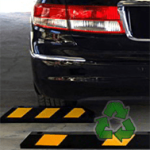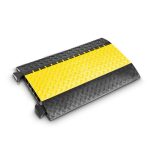The Pros of Rubber Speed Bumps
Effective in slowing down traffic
Rubber speed bumps are highly effective in slowing down traffic. They are designed to force drivers to slow down to a safe speed, making them an ideal solution for areas where speeding is a problem. Rubber speed bumps are also highly visible, which helps to alert drivers to the presence of the bump and encourage them to slow down. Additionally, rubber speed bumps are easy to install and maintain, making them a cost-effective solution for traffic calming measures. However, some drivers may find them uncomfortable to drive over, and emergency vehicles may be slowed down as well. Overall, the effectiveness of rubber speed bumps in slowing down traffic makes them a popular choice for many communities.
Cost-effective compared to other traffic calming measures
Rubber speed bumps are a cost-effective option when compared to other traffic calming measures. Traditional speed bumps made of concrete or asphalt can be expensive to install and maintain. In contrast, rubber speed bumps are relatively inexpensive and easy to install. They also require less maintenance than their concrete or asphalt counterparts, which can save municipalities and businesses money in the long run. Additionally, rubber speed bumps are a more environmentally friendly option as they can be made from recycled materials. Overall, rubber speed bumps offer a cost-effective solution for traffic calming needs.
Easy to install and remove
One of the biggest advantages of rubber speed bumps is their ease of installation and removal. Unlike traditional concrete speed bumps, rubber speed bumps can be easily installed and removed without the need for heavy machinery or specialized equipment. This makes them a popular choice for temporary traffic calming measures, such as during road construction or events. Additionally, their lightweight and flexible nature means they can be easily transported and stored when not in use. However, it is important to note that proper installation is still crucial to ensure the effectiveness and safety of the speed bumps.
Durable and long-lasting
Rubber speed bumps are known for their durability and longevity. They are made of high-quality rubber materials that can withstand heavy traffic and extreme weather conditions. Unlike traditional speed bumps made of concrete or asphalt, rubber speed bumps do not crack or break easily. They also require minimal maintenance, which makes them a cost-effective solution for traffic calming measures. However, some critics argue that rubber speed bumps can become slippery when wet, which can pose a safety hazard for drivers. Additionally, they may not be as effective in slowing down speeding vehicles compared to other types of speed bumps.
Environmentally friendly
Rubber speed bumps are considered to be environmentally friendly as they are made from recycled materials. This means that they do not contribute to the depletion of natural resources and help in reducing waste. Additionally, rubber speed bumps are reusable and can be easily removed and relocated, making them a sustainable option. However, it is important to note that the production of rubber speed bumps still requires energy and resources, and their disposal can also have negative environmental impacts if not done properly. Overall, while rubber speed bumps may not be a perfect solution, they do offer some benefits in terms of sustainability.
The Cons of Rubber Speed Bumps
Can cause discomfort and damage to vehicles
Rubber speed bumps can cause discomfort and damage to vehicles if they are not installed properly or if they are too high. Vehicles with low ground clearance, such as sports cars, may scrape against the speed bump, causing damage to the undercarriage. Additionally, repeated exposure to speed bumps can cause wear and tear on a vehicle’s suspension system, leading to costly repairs. Drivers may also experience discomfort or pain if they drive over speed bumps too quickly or at an awkward angle. It is important for municipalities and property owners to carefully consider the placement and height of rubber speed bumps to minimize the risk of damage to vehicles and discomfort to drivers.
May increase noise pollution
Rubber speed bumps may increase noise pollution, especially in areas with heavy traffic. The sound of vehicles passing over the bumps can be loud and disruptive, especially at night. This can be a concern for residents living near the speed bumps. However, some rubber speed bumps are designed to reduce noise pollution by incorporating a textured surface that reduces the sound of tires passing over them. Additionally, the use of rubber speed bumps can also reduce noise pollution caused by speeding vehicles, which can be a safety concern in residential areas. Overall, the impact of rubber speed bumps on noise pollution depends on their design and placement.
Can be a hazard for cyclists and motorcyclists
Rubber speed bumps can pose a hazard for cyclists and motorcyclists. The raised surface of the speed bump can cause a loss of balance, especially for those riding at high speeds. In addition, if the speed bump is not clearly marked or visible, it can catch riders off guard and lead to accidents. To mitigate this risk, some cities have implemented alternative traffic calming measures, such as speed cushions or chicanes, that are designed to slow down traffic without creating a hazard for cyclists and motorcyclists.
May cause delays for emergency vehicles
One major concern with rubber speed bumps is that they may cause delays for emergency vehicles. When responding to an emergency, every second counts, and speed bumps can slow down response times. While some speed bumps are designed to allow emergency vehicles to pass over them without slowing down, this is not always the case. In some instances, emergency vehicles may need to slow down significantly or even come to a complete stop to navigate over the speed bumps. This delay could potentially be life-threatening in certain emergency situations. As a result, it is important to carefully consider the placement and design of speed bumps to ensure that they do not impede emergency response times.
May not be effective in reducing speed for all drivers
While rubber speed bumps can be effective in slowing down some drivers, they may not be as effective for others. Some drivers may simply ignore the speed bumps and continue to drive at their usual speed, while others may slow down only temporarily before speeding up again. Additionally, some drivers may find the speed bumps to be a nuisance and may try to avoid them altogether, which could lead to dangerous maneuvers on the road. Therefore, it is important to consider other traffic calming measures in addition to rubber speed bumps to ensure the safety of all drivers on the road.










